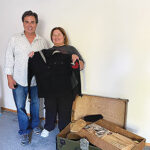
State’s fire insurance crisis dampens the dream of rural home ownership
By R.D. Tucker
Under normal circumstances, a home-hunting family would jump through all the qualification hoops and acquire a traditional mortgage, then go forth and seek the quiet property of their dreams in one of hundreds of rural communities sprinkled throughout the Sierra Nevada foothills, including Mariposa County.
Under that scenario, they would find that almost-perfect, nature-surrounded residence and then secure homeowners’ insurance. Typically, the buyers could shop around for the best homeowners’ coverage at affordable premiums to cover their home and property. That option doesn’t exist anymore.
Over the hill and through the woods comes the California FAIR Plan to the rescue. But many in the real estate or insurance industries question the “fair” moniker.
According to its website, “The California FAIR Plan Association was established to meet the needs of California homeowners unable to find insurance in the traditional marketplace. The FAIR Plan is not a state agency, nor is it a public entity. There is no public or taxpayer funding.
The FAIR Plan is a syndicated fire insurance pool comprised of all insurers licensed to conduct property/casualty business in California. The FAIR Plan was established by statute (California Insurance Code sections 10091 et seq.) in August 1968 as an insurance placement facility.
All licensed property/casualty insurers which write basic property insurance required by Insurance Code sections 10091(a) and 10095(a) are members of the FAIR Plan. The FAIR Plan issues policies on behalf of its member companies. Each member company participates in the profits, losses, and expenses of the plan in direct proportion to its market share of business written in the state.”
So, in other words, all the traditional insurers who used to issue homeowners coverage throughout the state are now part of this pool and based on the exorbitant rates for catastrophic insurance coverage (no standard liability, water damage or theft coverage), one would assume the profits are substantial. Most of those same insurance companies do offer the supplemental insurance that homeowners purchase to protect them from uncovered property losses.
The mere cost of fire insurance and wind damage coverage (catastrophic insurance), along with mortgage insurance rates that have more than doubled in the last three years, is driving middle class buyers out of the real estate market in rural communities, and in many markets throughout the state. And it’s not just affecting the buyers, but multiple companies are not renewing the policies held by rural-area homeowners, leaving them at the mercy of the FAIR plan pool, and out of options.
Some homeowners, typically retired individuals who own their homes outright, are opting out of insurance coverage due to the sky-high premium structure. Several of the residences that were destroyed in the destructive Oak Fire of 2022 were not insured.
At least in California, the “American Dream” gets further and further out of reach for most working families. It’s not just the higher interest rates that are disqualifying buyers, but the cost of homeowners insurance in rural markets.
Roger Brunelle, who operates the State Farm Insurance office in Mariposa, described why the FAIR plan premiums continue to rise. His office assists property owners who have had their insurance non-renewed, or those making a purchase. With all of the traditional insurance carriers pulling out of the homeowners’ market, that leaves property owners with the lone option of insurance provided by the pool of insurers that operate the FAIR plan.
“The FAIR plan operators get hundreds of applications every day. Since it was designed to provide coverage for almost every instance, they write more and more policies, which creates more and more shared liability, therefore creating increased costs as the number of properties insured increases,” Brunelle explained. “The FAIR plan rates are really high because it was intended to be a stop-gap measure, a temporary solution, but now that it has such high exposure from a catastrophic event, even the bare bones policy costs at least twice as much as what a traditional policy would cost,” he added.
“I know State Farm and all the other major carriers are working with the department of insurance on trying to find a solution,” Brunelle said. “One of the problems is that in California, carriers aren’t allowed to pass on their reinsurance cost to consumers. As a company, State Farm doesn’t want to go broke, so it takes out reinsurance to cover its losses, but we haven’t been able to pass that along to policyholders. Homeowner coverage in California hasn’t been priced properly for years.”
“Also in California, insurance companies aren’t allowed to use forecasting models. We need to include climate change in our modeling projects, but the state says we can’t,” Brunelle said.
Because of state restrictions, premiums for homeowners’ insurance haven’t kept pace with the true cost of coverage. “Our company recently made the decision not to renew coverage on 30,000 homes in the brushy areas of Southern California. I’ve never seen anything like that,” Brunelle exclaimed.
“But I feel optimistic. It’s trending in the right direction. I know the governor is working with the department of insurance to reduce the time involved for rate increases, which used to take up to a year and a half. They may be able to reduce that to 60 days, which could make a big difference for traditional insurers,” he added.
Jeff Shaw’s Farmers Insurance Agency in Mariposa has assisted hundreds of property owners with aquiring coverage through the FAIR plan. “The coverage under the FAIR plan can vary tremendously. There are several different factors like the distance to a fire station or fire hydrant, replacement cost, type of construction, age of the home and much more,” Shaw explained. “We submit the package for an initial quote but when the official quote comes back it can be quite a shock. We had one initial quote of $1,238 per year, but the official quote came back at $4,045.”
The FAIR plan coverage is a-la-carte. Buyers can pick and choose their coverage, but the lender can set specific requirements to insure its investment. “They can go through and pick their coverage, most of our time is spent walking people through this process. We do it all day, every day, and we’ve got 1,000 policyholders or more,” Shaw added.
“All the wildfires and catastrophes we’ve had in California and the restrictions from the state department of insurance are driving this,” Shaw said. “Every day this market is changing, and more restrictions go into place and more carriers are pulling out. Up here, we are going to face challenges for a long time.”
According to Shaw, California is one of the least expensive states in the country for just insurance in general. He cited homeowner rates in Florida of $11,000 per year on average. However, Mariposa County is the fourth worst county in the state for the number of homes exposed to a wildfire zone. “There’s not a lot positive going for us in these areas when it comes to insurance,” Shaw concluded.
The cost of insurance is having a devastating effect on the local real estate market.
“We’ve had escrows canceled because it took way too long for them to get the insurance from the California FAIR plan,” said Rick Lobaugh, who operates Mariposa County’s only title company, Inter-County Title. “We’ve also had escrows canceled because the insurance is one of the last processes that happens, and the costs of insurance prices them out of being able to afford the monthly payment.”
“It’s just become another hindrance (homeowners’ insurance). Our buyers are dealing with affordability. The cost of insurance has gone up so drastically, our interest rates are higher, and the inventory is pretty low so that is keeping prices up,” said Courtney Twiss with Twiss Realty Group, which is brokered by EXP Luxury Realty.
“A lot of buyers are sitting on the sidelines because of affordability. Now a lot of the time the cost of insurance is putting their loan qualification out of reach,” Twiss added.
“We’ve definitely seen it (insurance cost) price buyers out of purchasing a home, especially the middle-class buyer. We’re working closely with the lenders now. We can get a quote back in less than 30 days, but we’ve lost sales because the insurance cost is putting the buyers’ mortgage qualification out of reach,” said Rebecca Hatcher, owner and broker of Yosemite Realty.
“I think it’s sad. The only thing that would help right now is lower interest rates, but I think insurance costs are just going to keep going up and up. Unless prices really come down so more buyers can qualify, I think the only solution for our middle-class buyers is lower interest rates,” she added.
Cary Griffith, the owner and broker of Century 21 Sierra Realtors said, “Knock on wood, we haven’t had anybody cancel due to the high cost of insurance yet. I’m always careful, but we haven’t had this issue interfere with an escrow so far, but we know it’s a prevalent problem.”
“It used to be that agents could get a quick quote from the FAIR plan, then they changed the internet portal and now it’s at least a 30-day process. The problem is expanding into the central valley now too. Now they are sending out adjusters and they have the right to put conditions on your policy. It’s a complicated process and I think it’s going to get worse now that the FAIR plan is the only one left standing,” Griffith added.
“It’s creating a real problem,” said Brett Baumann, broker and owner of Catheys Valley Real Estate and Mariposa Homes and Land offices. “It takes us 21 to 30 days to get a quote and by the time they close escrow it’s two to three times what we used to pay for homeowners’ insurance. It’s insane.”
“It almost seems like they are trying to force people out of rural communities. It doesn’t make any sense to me but it’s causing major problems in the real estate industry. It’s not sustainable, and it’s eliminating the middle-class buyer,” Baumann added.
If there is going to be any light at the end of this tunnel, it will certainly take a combination of lower interest rates and a less-regulated insurance industry, since competition always creates lower costs.
















